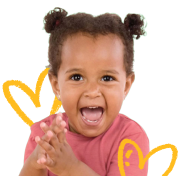
Depending on the age of your baby or toddler you may want to incorporate music and movement as an integral part of their learning curriculum. By including music the goal is generally to improve their motor skills and introduce them to rhythms. Depending on the age and learning stage of your baby you can opt for signing the majority of the lyrics or simply selecting concrete concepts and simple abstracts that match baby’s developmental stage.
The number of age-appropriate songs for babies and toddlers is endless. As a parent or caregiver, you often have the opportunity to introduce baby to new concepts and even world culture if your home happens to be multilingual and multicultural. For us, these songs have proved to be our favorites. We are including links to some of the signs you can incorporate as you work together and have fun learning these songs.
Itsy Bitsy Spider Lyrics
The itsy-bitsy spider
Climbed up the water spout
Down came the rain
And washed the spider out
Out came the sun
And dried up all the rain
And the itsy-bitsy spider
Climbed up the spout again
Six Little Ducks Lyrics
Six little ducks that I once knew
Big ones, skinny ones, fair ones too.
But the one little duck with the feather on his back
He led the others with his quack, quack, quack.
Quack, quack, quack-quack, quack, quack
He led the others with his quack, quack, quack.
Down to the river they would go.
Wibble wobble, wibble wobble to and fro.
But the one little duck with the feather on his back
He led the others with a quack, quack, quack.
Quack, quack, quack-quack, quack, quack
He led the others with his quack, quack, quack.
Home from the river they would come.
Wibble wobble, wibble wobble, ho-hum-hum.
But the one little duck with the feather on his back
He led the others with a quack, quack, quack.
Quack, quack, quack-quack, quack, quack
He led the others with his quack, quack, quack.
Six little ducks that I once knew
Fat ones, skinny ones, fair ones too.
But the one little duck with the feather on his back
He led the others with his quack, quack, quack.
Quack, quack, quack-quack, quack, quack
He led the others with his quack, quack, quack.
Girls and Boys Come Out to Play
Girls and boys, come out to play,
The moon doth shine as bright as day;
Leave your supper, and leave your sleep,
And come with your playfellows into the street.
Come with a whoop, come with a call,
Come with a good will or not at all.
Up the ladder and down the wall,
A halfpenny roll will serve us all.
You find milk, and I’ll find flour,
And we’ll have a pudding in half an hour
These are just a few of our favorite songs. We don’t require our little ones to sign every single word; Instead, we focus on play, movement and expression.
Do you have a favorite song or rhyme for baby?











